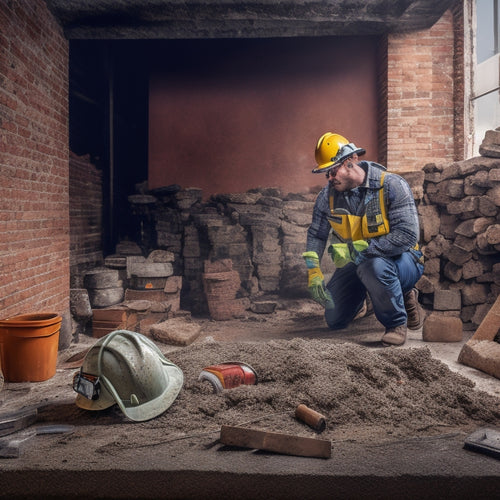
Why Stacking Safety Matters for Home Renovation
Share
When you start a home renovation, you're exposed to various safety risks, including improper stacking of heavy materials like concrete blocks, which can lead to accidents, injuries, and property damage. Concrete blocks, weighing between 30-50 pounds, pose weight risks during handling, and improper storage can cause unstable stacks and collapses. To mitigate these risks, you need to prioritize correct lifting methods, use personal protective equipment, and implement proven stacking techniques, such as securing heavy objects at the bottom or middle of the stack and ensuring even weight distribution. By understanding these hazards, you can take the first step towards a safer renovation project, and discover more strategies to protect yourself and your property.
Key Takeaways
• Improperly stacked concrete blocks can lead to accidents, injuries, and property damage during home renovation projects.
• Stacking safety ensures structural integrity, preventing top-heavy loads and unstable stacks that can collapse and cause harm.
• Proper stacking techniques, such as weight distribution and secure bases, reduce the risk of accidents and injuries.
• Regular inspections of block stacks identify hazards, allowing for prompt corrective action and minimizing renovation downtime.
• Effective stacking safety practices enhance overall site organization, communication, and management, leading to a safer and more efficient renovation project.
Safety Risks in Home Renovation
When undertaking a home renovation project, you expose yourself to a multitude of hazards that can result in physical harm, property damage, and even legal liabilities.
It's vital to acknowledge that renovation oversight is important to mitigating these risks. Effective hazard identification is the first step in this process. You must be vigilant in identifying potential hazards, such as structural weaknesses, electrical issues, and asbestos presence. Failure to do so can lead to devastating consequences, including accidents, injuries, and even fatalities.
To guarantee a safe renovation process, you must take a proactive approach to hazard identification. This involves conducting thorough site assessments, reviewing building codes and regulations, and consulting with experts when necessary.
By doing so, you can develop a detailed risk management plan that addresses potential hazards and minimizes the likelihood of accidents. Remember, renovation oversight isn't just about compliance; it's about protecting yourself, your workers, and your property from harm.
Concrete Block Handling Hazards
When you're handling concrete blocks, you're not just dealing with heavy materials - you're also dealing with potential safety hazards.
You'll need to evaluate the weight risks associated with concrete blocks, which can be deceptively heavy and cause injuries if not handled properly.
Additionally, you'll want to make sure you're using proper lifting techniques to avoid straining your back or causing other musculoskeletal injuries.
Block Weight Risks
You'll encounter significant weight risks when handling concrete blocks, which can weigh anywhere from 30 to 50 pounds each, depending on their size and type.
Improper block storage can lead to weight distribution issues, causing stacks to become unstable and prone to collapse. When you're handling blocks, it's crucial to reflect on the weight of each block and how it will affect the overall stability of the stack.
To mitigate these risks, you should always follow proper block storage guidelines. This includes storing blocks on a firm, level surface and ensuring that the weight is evenly distributed across the stack.
Avoid storing blocks near edges or ledges, as they can easily topple over. Additionally, make sure to stack blocks in a way that allows for easy access and removal, reducing the likelihood of accidents.
Improper Lifting Techniques
Improper Lifting Techniques
Beyond weight risks, improper lifting techniques pose a significant threat to your safety when handling concrete blocks, as they can lead to strains, sprains, and other musculoskeletal injuries. As you lift concrete blocks, you're not just lifting the weight of the block itself, but also the weight of your own body. This can put immense pressure on your back, shoulders, and knees, leading to lifting injuries.
To avoid these injuries, it is crucial to adopt ergonomic practices when lifting concrete blocks. Here are some key tips to keep in mind:
| Incorrect Lifting Techniques | Correct Lifting Techniques |
|---|---|
| Bending at the waist | Keeping your back straight |
| Twisting while lifting | Lifting with your legs |
| Holding the block far from your body | Holding the block close to your body |
Safety Gear for Concrete Block Handling
Handling concrete blocks requires wearing personal protective equipment (PPE) that guards against injuries from heavy lifting, falling blocks, and sharp edges. You must prioritize safety when working with concrete blocks, as they can be hazardous if not handled properly.
Wearing the right protective gear, such as hard hats, safety glasses, gloves, and steel-toed boots, is crucial to prevent injuries. In addition, you should wear a dust mask to prevent inhaling dust and debris when cutting or drilling concrete blocks.
When it comes to handling techniques, you should always lift blocks correctly, using your leg muscles to do the heavy lifting, rather than your back. This will help prevent strains and sprains.
You should also maintain a secure grip on the blocks, making sure they don't slip or fall, causing accidents. Moreover, always inspect the blocks for damage or defects before handling them, and use proper storage and stacking techniques to prevent blocks from toppling over.
Proven Stacking Techniques Matter
When you're stacking concrete blocks, you'll want to prioritize securing heavy objects first, ensuring they're stable and won't topple over.
Next, you'll need to balance weight carefully, distributing it evenly to prevent any single point from becoming too heavy.
Secure Heavy Objects First
You must prioritize securing heavy objects on the bottom or middle of the stack to prevent top-heavy loads that can topple over and cause accidents. This is essential for load distribution and weight stabilization. By placing heavier items at the base or center, you guarantee a more stable foundation for the rest of the stack. This simple yet effective technique helps prevent accidents and injuries.
Here are some key considerations to keep in mind when securing heavy objects:
-
Distribute weight evenly: Make sure the weight of the heavy objects is spread out evenly across the stack to prevent uneven load distribution.
-
Use sturdy bases: Choose bases that can support the weight of the heavy objects and the rest of the stack.
-
Avoid overhanging: Confirm that heavy objects don't overhang the edges of the stack, which can cause instability.
-
Keep it centered: Place heavy objects close to the center of the stack to maintain weight stabilization.
-
Monitor the stack's height: Be mindful of the stack's height and adjust the placement of heavy objects accordingly to prevent toppling.
Balance Weight Carefully Always
By meticulously balancing weight, you guarantee that your stack remains stable and secure, as uneven distribution can lead to catastrophic collapses.
When you're stacking materials for your home renovation project, it's vital to prioritize weight distribution. A well-balanced stack guarantees load stability, reducing the risk of accidents and injuries.
To achieve the best weight distribution, start by identifying the heaviest items and placing them at the bottom of the stack. This provides a solid foundation and prevents top-heavy loads that can topple over.
Next, arrange items of similar weights together, gradually decreasing the weight as you move up the stack. Be mindful of the center of gravity, keeping it low and centered to maintain stability.
Preventing Concrete Block Accidents
Concrete block accidents often occur due to improper lifting, handling, and placement techniques, which can lead to serious injuries and even fatalities.
As you work on your home renovation project, it's crucial to prioritize concrete block safety to avoid accidents. You must guarantee that you're using proper stacking techniques to maintain block stability.
Here are some critical tips to prevent concrete block accidents:
-
Always lift blocks correctly, bending at the knees and using your leg muscles to lift, rather than straining your back.
-
Handle blocks with care, avoiding sudden movements or jerks that can cause them to slip or fall.
-
Place blocks on a level surface, ensuring they're securely positioned to prevent toppling or shifting.
-
Use proper bracing and support systems to maintain block stability, especially when building high walls or structures.
-
Regularly inspect your block stacks to identify and address any potential hazards or weaknesses before they cause an accident.
Effective Site Management Strategies
As site management plays an important role in guaranteeing a safe and efficient home renovation project, it's vital to implement effective strategies that promote a well-organized and controlled work environment.
You must prioritize site organization by designating specific areas for materials, tools, and equipment. This will help prevent clutter, reduce tripping hazards, and guarantee that everything is easily accessible.
Establishing clear communication protocols is also essential for effective site management. You should designate a central point of contact for all stakeholders, including contractors, suppliers, and clients. This will guarantee that everyone is informed and aligned throughout the project.
Implementing a digital communication platform, such as project management software, can facilitate real-time updates, streamline workflows, and reduce miscommunication.
Frequently Asked Questions
Can I Reuse Concrete Blocks That Have Been Damaged or Broken?
When evaluating damaged or broken concrete blocks for reuse, you must prioritize block repair and structural integrity.
Don't compromise the entire structure by reusing compromised blocks.
Inspect each block carefully, looking for signs of cracking, crumbling, or damage that could affect its load-bearing capacity.
If in doubt, it's best to err on the side of caution and replace the block to guarantee a safe and sturdy structure.
How Often Should I Inspect My Scaffolding During a Renovation Project?
When it comes to scaffolding safety, you should prioritize regular inspections to guarantee a secure working environment.
You'll want to inspect your scaffolding daily, before each use, and after any alteration or repair.
Additionally, consider conducting a thorough inspection every 7-10 days, or after exposure to harsh weather conditions.
This frequency will help you identify potential hazards and address them promptly, reducing the risk of accidents and injuries during your renovation project.
Are There Specific Regulations for Concrete Block Storage on Site?
When storing concrete blocks on site, you must adhere to specific regulations to guarantee site safety.
According to OSHA guidelines, blocks should be stacked in a stable manner, with each layer aligned and secured to prevent collapse.
You'll also need to maintain a clear access path and store blocks away from power lines and other hazards.
Additionally, local building codes may impose further requirements, so be sure to check with authorities before commencing block storage on your site.
What Is the Maximum Weight Capacity for a Concrete Block Stack?
As you ponder the limits of concrete block stacking, imagine the weight of your entire project resting on a precarious tower.
But fear not, for there's a science to it! The maximum weight capacity for a concrete block stack depends on weight distribution and block stability.
Generally, a safe stack shouldn't exceed 4-6 blocks high, with each block weighing around 35-40 pounds.
However, it's essential to consult the manufacturer's guidelines and consider factors like block size, material, and site conditions to guarantee a stable and secure structure.
Can I Stack Concrete Blocks on Uneven or Sloping Ground Surfaces?
When you're planning to stack concrete blocks, it's essential to assess the ground surface.
You shouldn't stack blocks on uneven or sloping ground, as it compromises foundation stability. This unevenness disrupts load distribution, putting excessive pressure on certain blocks, which can lead to structural failure.
Instead, make sure the ground is level and compacted to maintain stability and even weight distribution, allowing your block stack to bear the intended weight safely.
Conclusion
As you wrap up your home renovation, remember that safety is the foundation upon which your dream project is built.
Like a house of cards, a single misstep can bring it all crashing down.
By prioritizing concrete block handling safety, you'll prevent accidents and guarantee a sturdy structure that stands the test of time.
Don't gamble with your well-being – stack safety at the top of your renovation checklist.
Related Posts
-

Crack Repair Inspection Checklist for Home Renovation
When creating a crack repair inspection checklist for your home renovation project, you'll want to identify crack typ...
-

7 Must-Have Safety Gears for Brick Wall Renovation
When renovating a brick wall, you'll face a multitude of hazards, making it essential to wear and use the right safet...
-

Budget-Friendly Materials for Your Home Renovation Needs
As you initiate your home renovation, you're enthusiastic to find budget-friendly materials that fit your vision with...


